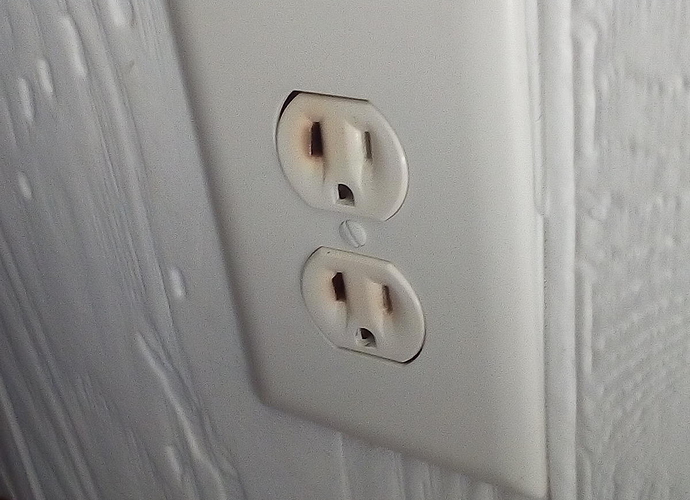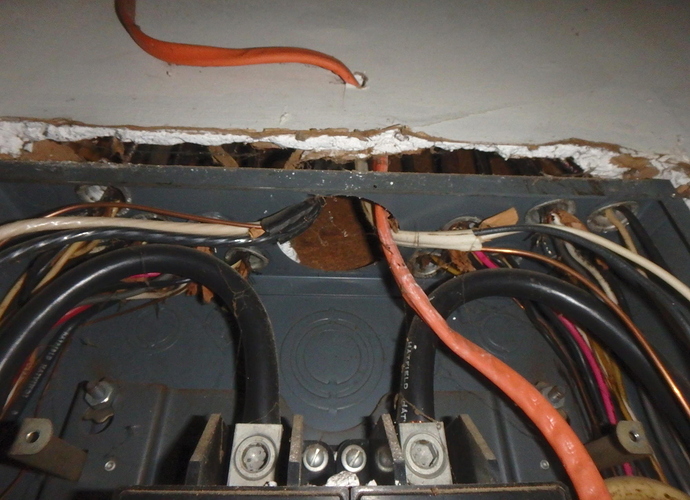This is a typical rectangular electric meter provided by the electrical utility. It’s shape suggests a 200 amp service. It is properly secured to the electrical pole.
I researched Carbon Monoxide in the online library. Carbon monoxide is a colorless and odorless gas that is formed by the incomplete combustion of materials. Nearly 500 Americans died between 2001 and 2003 from non fire related Carbon Monoxide poisoning. It is important to recommend the installation of CO detectors to help prevent injury and death from CO poisoning.
Electrical Essay
This is an image of a newly installed 200 amp panel box. It was installed with the proper clearances. No open knockouts and wired correctly. Very neat professional job.
I thought i would discuss Chinese drywall. Strontium sulfide was prevalent in the fly ash used in the manufacturing of this drywall. I was a Building Inspector at the time and the first usage of this material in our town was in one of the homes i was inspecting. First sign was the smell. Then upon further inspection I noticed the ends of the wires were black looking. I called in the electrical inspector and he said something had caused the cooper to turn that color. After more investigation I discovered that the drywall was from china. This became a hot topic with the city and after much research we started enforcing no usage of this product and require any that had been installed had to be replaced. A lot of builders did not like it, however we worked for the people not the builders.
During this inspection I noted a receptacle with evidence of charring. A certified electrician should be consulted to replace this receptacle as it could now be faulty.
I researched the article on electrical service panels. In future inspections will be on the look out for Zinsco and FPE panels. Wearing proper PPE will be standing practice for me to protect against arc flashing at the service panel.
Article: Website Optimization and Online Marketing: Google, Yahoo & Bing Local Listings
Essay: This article gives a good over-view of how to get seen online when potential customers search for home inspectors. I get calls routinely for my real estate brokerage from marketing companies that require a monthly fee to get you to the top of google searches. I’m curious to see how successful I can be at managing this myself using the site and tips that were listed.
For full disclosure, this is not my picture but an identical situation as the one I am wanting to discuss. I was unable to take a picture myself but my hvac system failed yesterday due to water build up in the pan causing the SafeT switch to kill the system to prevent over flow. There is a good chance insulation or algae has clogged the drain line. As an inspector, I would note that the pan has been holding standing water and should be evaluated by a licensed hvac tech.
The picture shows a 220 breaker utilizing a white conductor as a ungrounded hot. This should have a piece of black electrical tape wrapped around it on both ends to show it is being used as a ungrounded hot.
This is a Siemens combination distribution panel located on the east wall of a basement utility/storage room. The panel uses breakers & numerous 240-volt, 120-volt & multi-wire branch circuits can be seen. There is also an AFCI breaker. One obvious condition in this photo, which is a safety hazard, is the opening in the panel.
Visible conductors are non-metallic sheathed cable & the service entrance cables enter the building through the concrete foundation just above the panel. This home has apparent 200 amp service.
Arc-Fault Circuit Interrupters (AFCIs) - by Nick Gromicko & Kenton Shepard
Arc-Fault Circuit Interrupters are electrical receptacles & circuit breakers which serve an important function: to detect electrical arcs in branch wiring & to shut off power to the affected circuits to prevent structure fires.
An arc occurs when electric current crosses an air gap from one energized component to a grounded component. An example of this is when wire insulation is damaged from a homeowner using nails or screws to hang a picture or install shelving. The current-carrying wire is now exposed & an arc can occur, which may ignite flammable building materials in the vicinity.
The article references the 2006 International Residential Code with regard to AFCI requirements: “All branch circuits that supply120-volt, single-phase, 15- and 20-amp outlets installed in bedrooms shall be protected by a combination-type or branch/feeder-type arc-fault circuit interrupter installed to provide protection of the entire branch circuit.”
NOTE: The 2015 Canadian Electrical Code states that “each branch circuit supplying 125 volt receptacles rated 20 A or less shall be protected by a combination type arc fault circuit interrupter”. The code lists some exceptions such as where there is a single receptacle for a sump pump (further criteria is outlined), where “an outlet branch circuit type arc-fault circuit interrupter is installed at the first outlet on the branch circuit”, & where “the wiring method for the portion of the branch circuit between the branch-circuit overcurrent device and the first outlet is comprised of metal raceway, armoured cable, or non-metallic conduit or tubing.”
WOVEN IN TIME HOME INSPECTIONS
INSPECTION REPORT FOR TEST PROPERTY
Inspection of the electrical system appears to have reviled that this property has two separate and distinct disconnects and a sub panel. The old 1824 structure has a main disconnect with a sub panel and the 1980 addition has a separate disconnect. From visual inspection of the entrance meter and utility feeds the old structure is fed through the foundation and the 1980 service is fed underground. Because of the age of the property and the numerous changes that would have occurred over time and owners it is recommended that a licensed electrician be consulted.
The following observations will need to be addressed:
Underground outlets where found
Improper wiring was used in the paneled room in the basement
Nonworking switch in the north west bedroom
No gfci outlets in the bathroom for the south west and east bedrooms
Because of the properties age and the many changes over time there is all likelihood additional electrical issues.
View of two service entrances
https://www.nachi.org/forum/attachments/f25/141591d1466615962-perform-residential-electrical-inspections-main-service-old-part-house-012.jpg
No labels on disconnect box
https://www.nachi.org/forum/attachments/f25/141592d1466615992-perform-residential-electrical-inspections-main-service-old-part-house-006.jpg
Speaker wire to switch controlling overhead light
https://www.nachi.org/forum/attachments/f25/141593d1466616211-perform-residential-electrical-inspections-main-service-old-part-house-003.jpg

This panel seems to be OK overall, but a couple of minor issues. The screw is hardly screwed in, just seems to be more so of laziness rather than a problem. The labeling doesn’t seem to be great, it seems all breakers are not labeled on the ledger.
For this essay assignment I chose to read the article “AFCI Testers”. AFCI Testers creates waveform patterns similar to an actual arc fault, so it should cause it to trip. The indicator is inserted into the receptacle and creates pulses of amp charges. The effectiveness of these devices is debated.
I inspected the electrical panel. It was labeled and free of any missing knockouts. No defects noted.
As indicated by the GFCI tester, the hot and neutral conductors at this receptacle are reversed. Reversed polarity presents an electrocution hazard. Further evaluation and repair by a licensed electrician is recommended.
Research Exercise
*“Inspecting Aluminum Wiring”
*Houses built between 1965 and 1973 are more likely to have aluminum wiring due to the high price of copper at the time. Aluminum wiring, compared to copper wiring, is unreliable and poses safety hazards. The evaluation of aluminum wiring should be deferred to a licensed electrician. There are two methods of repair recommended by the CPSC. Rewiring the house with copper wire is the most reliable, but most cost-prohibitive method. The use of copalum crimps to attach a piece of copper wire to the existing aluminum branch circuit is a less expensive repair.
This panel is from an older home which my client was purchasing as an investment property. This panel has several issues.
There are nails holding the 220 breakers. This is not an acceptable breaker tie.
There are several breakers which have been double lugged.
There are missing bushings missing with wires run through the holes with exposed sharp edges.
The main disconnect is an older pull type.
Recommended further review by a licensed electrician for this panel.
Electric panel safety should be taken seriously.
Do not open any panels where moisture is suspected or rust is present around the panel.
Keep hands out of panel. Do not allow the customer near the panel.
If anything inside the panel is not clear or questionable installation is present, refer to a licensed electrician.
Read the article on ant inspection. I thought the area that compared the differences of termites to ants was very interesting. The biggest difference in the appearance is the termite has a straight body where the ant has a small waist. Also the antennas on a termite are straight where the ant has a 90 degree turn. Very informational.













